Shoes

Different shoe categories: (from left) plastic boots, heavy trekking boot, light trekking boots, outdoor shoes, sandals.
Shoe categories
Today there is no fixed labelling of shoes for individual activities. Some producers point to the target use, some divide shoes into categories according to letters. The below stated division is a synthesis of both and it is not unique. It should help readers to understand different types to shoes.
Sandals - shoes which you will find great on long trips and when resting
Category A - Sometimes called “outdoor shoes” (low sport shoes). Low light shoes for everyday wearing suitable for trips on easy terrain.
Category A/B - light trekking boots – ankle boots for trekking in a non-demanding terrain, frequent mountain routes, trips without a heavy rucksack
Category B - higher boots with a fixed heel, which you will use for trekking in more demanding terrain. You walk on steep mountain routes and carry a rucksack
Category B/C – very hard ankle boots with a high torsion stability. Boots for demanding trips in high mountains, in broken stones and steep slopes.
Category C – A hard robust construction designed for trekking in high mountains, crossing glaciers, getting though unmarked terrain. Crampons can be attached to them.
Category D - expedition boots, also plastic boots belong to this category. Boots for high mountaineering, when you move in snow. Using crampons is obvious.
Materials used for making shoes
In the time of modern materials and waterproof membranes it can seem that the classical concept of leather boots is outdated, however, the opposite is true. Every producer offers several models of trekking boots made from leather. Leather is a traditional material for making shoes and its advantage is mainly in durability. Leather is very good for winter boots, because boots have fewer seams and can easily be re-waterproofed.
Summer trekking boots use modern materials combined with leather, often layered with a membrane (Gore-Tex, water stopper etc.). They have more seams. A mechanical resistance of these boots is smaller than of a classical leather boot.
Sole – producers use different materials for making soles, but the Vibram material is a guarantee of a quality product. Soles have very different shapes. Producers try to get inspired in nature, so some soles have the shape of a lynx´s paw, a bear´s paw, etc.
Shoe choice
When choosing shoes it is necessary to answer several questions.
Where will you be?
According to the above stated division it is necessary to choose a shoe for the most frequent activity.
What is your weight? How heavy will your rucksack be?
The heavier you are and the heavier rucksack you carry, you have to choose boots for more demanding conditions.
How long will your trips be?
For longer trips always choose boots for more demanding conditions. This way, your boots will not wear out during your travelling activity.
How to try shoes
Try boots from the bigger size to the smaller size. Make sure that when you are trying new boots, that you are wearing the socks you will wear during your activity. When you buy boots of a high quality, do not compromise on socks. Socks for trekking boots are specially constructed for demanding use and their heel and toe are hardened. Tie boots in a way so that the heel fits you perfectly. Draw boots tight with shoelaces and walk up and down some stairs and a slope, etc. The heel has to fit with no pinch. If the boot is uncomfortable, try a boot from a different producer.
The boot size is not restricted only to the foot length, but also its width. Some producers use labelling for a wide foot – W (wide).
Maintenance
All shoe types require regular maintainace. You should clean your boots, dry them and impregnate them. Impregnation ensures waterproofness of the outer layer and prolongs the life of used materials. To maintain touristic shoes you should not use common “polishes” for shoes. Use only products recommended by the producer. Polishes with a bees wax are best for maintaining leather boots.
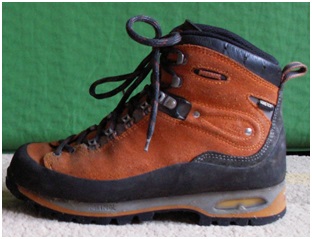 |
| Heavy trekking boot |
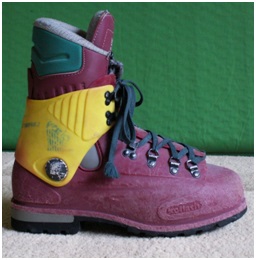 |
| Plastic boot |
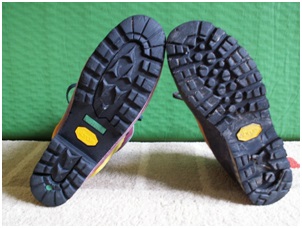 |
| Soles – plastic boot on the left, leather trekking boot on the right |
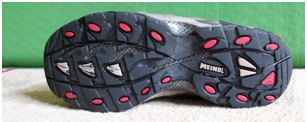 |
| Sole of a trekking shoe |
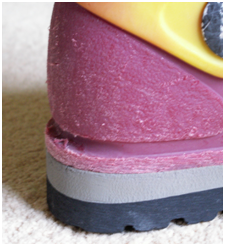 |
| Heel groove for crampons |
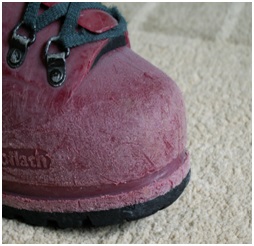 |
| Front groove for crampons |
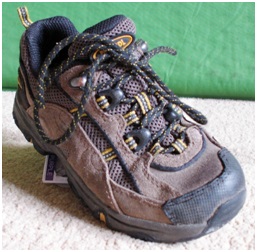 |
| Children outdoor boot |
